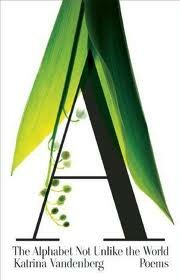A Working Mother’s Perspective: Katrina Vandenberg on Art and Fear

Milkweed Editions, May 2012.
When I seek advice from poets about how they do it — and don’t we all? — there seems to be a nearly-sacred belief about how you have to clear your schedule so you can write.
I have found the opposite to be true: often, we don’t need nearly as much empty space in our lives as we think we do. In fact, the more time I have, the more time I have to ruminate, the more tasks expand to fill the time I have, and the less I feel compelled to do.
Over the years, I’ve found that I need to be in the world to fill my artistic well, and to push against the world to do my best creative work. Two of the best things that have happened to my poetry have been a full-time job and a child, and yes, I do mean both at the same time.
Here’s what’s different, and often better, about writing these days:
1. No dilly-dallying. I now have less time to write than I used to have to sit in a coffee shop with a girlfriend and complain about how I had no time to write. (I think I stole that line from an old issue of Utne Reader.) But when I sit down to write now, I write. No Facebook, no e-mail, no fridge, no letting a stack of student papers magically grow until it takes an entire day to grade them. It’s a race between me and my daughter, Anna, waking from her nap — and the bits of writing I do get done keep building over time.

Simon & Schuster, Reprint Edition, December 2005.
2. Perspective. My daughter spends all day, every day, failing. She failed at sitting up for months, until one day she could. Ditto crawling, walking, drinking out of a cup, speaking in a complete sentence. Her persistence makes me feel like a bit of a loser for freaking out when I can’t write a poem that’s as good as one by Louise Glück in one sitting. Perfectionism is a luxury I can no longer afford (it didn’t serve me well, anyway).
3. Play. When I don’t have child care so that I can be doing my job, I’m playing. This makes me sound magnanimous, but really, I have no choice. I build block towers, I read the same book for the 2,682nd time, I do voices, I go to the rainforest room at the local conservatory with Anna and look at the pool of stingrays. My play-life with Anna has seeped into my writing; now, when I write, I have more fun than I have in years.
This has always been true, of course: the poems I most loved writing, and the ones I was most pleased with after I wrote them, were poems whose creation felt like play. Many of the alphabet poems in my new book, like “M,” or the poem “Tulipomania” in my first book, ATLAS felt effortless and fun. But it’s a state I enter more easily these days.

Harcourt Children’s Books, September 1981.
I’m not suggesting you get knocked up for National Poetry Month, nor do I mean to romanticize chaos — of course a poet needs a room of one’s own — but I am suggesting that maybe poets don’t say yes to the world, and themselves, as often as they might. The key is saying yes to things that feed you, not to being a do-gooder. But why not take the job? Why not get married, have a child, take the trip, see what [fill in the blank] might be like? What might be waiting for your poems on the other side?
Some books about creativity, all of which I love:
1. ART AND FEAR: Observations on the Perils and Rewards of Art-Making. By David Bayles and Ted Orland. I love this book because it’s not for geniuses, but for the rest of us. Kind of like The Artist’s Way without the self-help exercises and inner-child component, it’s made me much more aware of my process.
2. THE GIFT, by Lewis Hyde. This book changed my life. It’s not a how-to: it’s a sprawling tome about the value of creativity in a life well-lived, and the difficulty of pinning a market value on creative work. A book you keep.
3. THE CREATIVE HABIT: Get It and Use It for Life, by Twyla Tharp. The most practical of the books listed here, with suggestions on how to concretely set creativity in motion. Tharp’s most sobering piece of advice: take a good look at what books you’re reading and who you spend time with; they’ll be shaping your art five years from now. I’ve tracked this since, and it turns out to be true for me, though my cycle was three years and not five. Don’t be put off by the book’s look-at-me design (I was, initially).
And two children’s books that have inspired me to write poems:
4. A VISIT TO WILLIAM BLAKE’S INN: Poems for Innocent and Experienced Travelers by Nancy Willard. When Nancy Willard was writing this book, she built a seven-foot-high dollhouse to be Blake’s inn. Isn’t that cool? This book comes as close to being a dollhouse on the page as any I’ve read.
5. LINNEA IN MONET’S GARDEN by Cristina Bjork. Unlike any other children’s book I’ve read; I love its scrapbook format. Linnea and her neighbor Mr. Bloom go to Paris and Giverny to see Monet’s paintings and his house, and even meet a living relative. A surprisingly moving book on the nature of creativity, considering that’s not what it’s really about.
Katrina Vandenberg is the author of THE ALPHABET NOT UNLIKE THE WORLD and ATLAS. She lives with her family in Saint Paul, MN, and teaches in the creative writing program at Hamline University, four blocks from her home.
